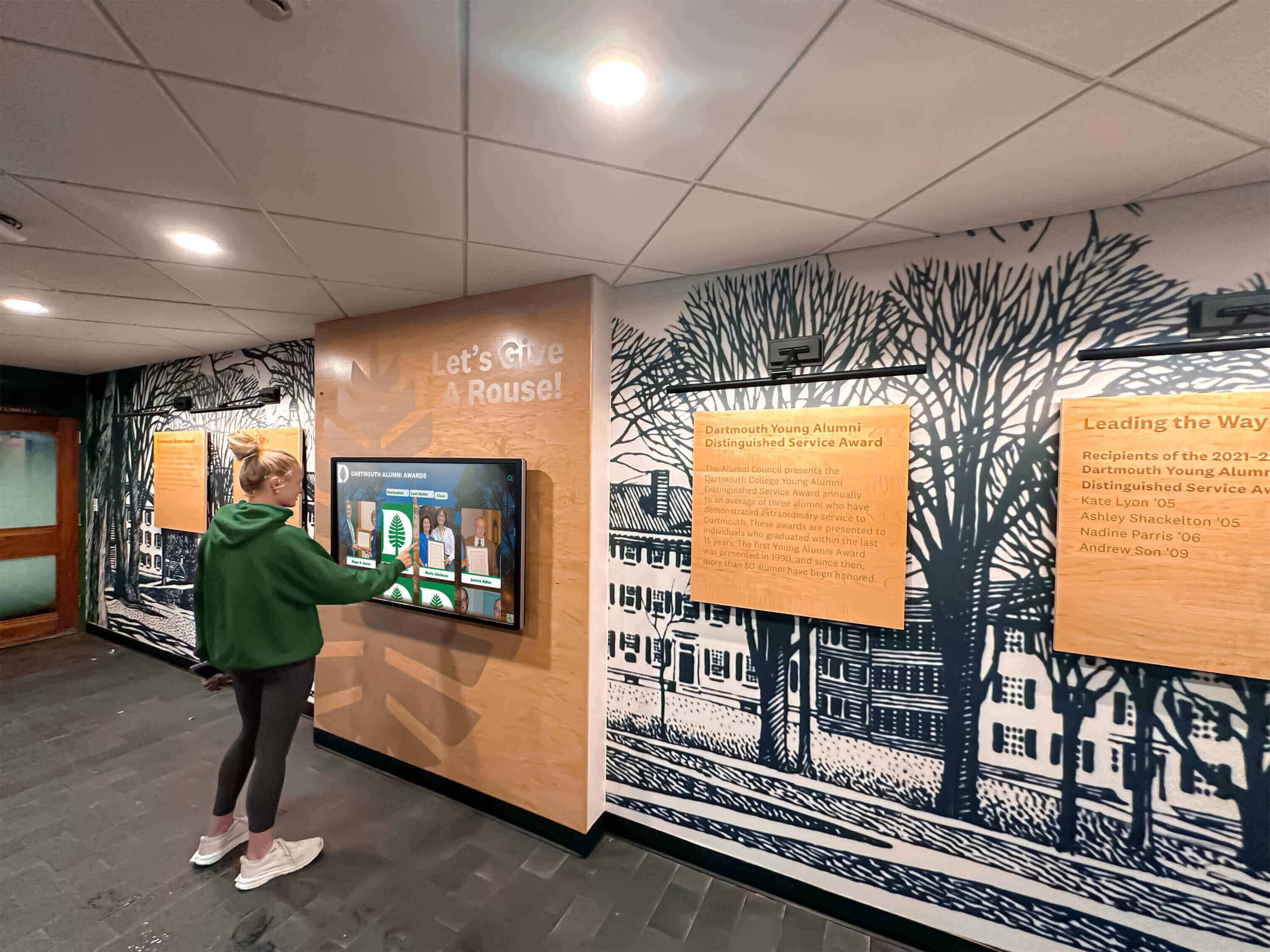Schools and organizations face an ongoing challenge when it comes to honoring achievements and building community pride: traditional recognition methods consume valuable wall space, require constant updates, and often fail to engage modern audiences who expect interactive digital experiences. The rise of interactive touchscreen technology has created new possibilities for recognition programs, with ClearTouch interactive panels emerging as one option institutions consider when modernizing their halls of fame.
This comprehensive guide explores how interactive touchscreen technology, including ClearTouch panels, can transform traditional recognition displays into dynamic, engaging experiences that celebrate achievements while strengthening institutional connections. We’ll examine the key features, implementation considerations, and best practices for creating effective digital hall of fame solutions.
Understanding Interactive Panel Technology for Recognition Displays
Interactive touchscreen panels have evolved significantly over the past decade, moving from specialized niche products to mainstream solutions adopted across education, corporate, and institutional settings. These large-format displays combine high-resolution screens with responsive touch technology, creating intuitive interfaces that visitors can explore through familiar gestures like tapping, swiping, and pinching.
The Evolution of Touchscreen Recognition
Traditional halls of fame relied entirely on physical displays: engraved plaques mounted on walls, framed photographs in hallways, trophy cases filled with memorabilia. While these methods honored achievements, they presented significant limitations. Physical space constrained how many individuals could be recognized. Updates required construction work, engraving services, and often substantial costs. Most critically, static displays failed to tell complete stories or engage visitors in meaningful exploration.
The transition to digital recognition began with simple slideshow displays, progressed through non-interactive digital signage, and has now reached fully interactive systems that respond to user input. Modern interactive touchscreen displays allow visitors to search for specific individuals, filter by achievement categories, view multimedia content, and discover connections between honorees and institutional history.
Key Technologies Powering Interactive Recognition
Several technological components work together to create effective interactive hall of fame displays:
Capacitive Touchscreen Technology: Modern interactive panels typically use capacitive touch sensors that detect multiple simultaneous touch points. This multi-touch capability enables intuitive gestures familiar to anyone who has used a smartphone or tablet, making the interface immediately accessible to visitors of all ages.
High-Resolution Display Panels: Contemporary interactive displays feature 4K or higher resolution, ensuring that text remains crisp and readable, photographs appear vibrant and detailed, and videos play smoothly. This visual quality is essential for creating professional recognition experiences that honor achievements appropriately.
Powerful Computing Systems: Behind the display, embedded computing modules run the software that manages content, responds to user interactions, and handles multimedia playback. These systems must balance performance with reliability, operating continuously in public spaces without requiring frequent maintenance or reboots.
Content Management Platforms: The software layer determines how easily institutions can update content, add new honorees, and modify recognition categories. Sophisticated touchscreen software solutions provide intuitive interfaces that allow non-technical staff to manage content without programming knowledge or IT department involvement.
ClearTouch Panels: Features and Capabilities
ClearTouch manufactures interactive flat panels primarily designed for educational and business environments. Their displays feature responsive touch technology, high-resolution screens, and robust construction designed for heavy use. While ClearTouch panels are commonly used for classroom instruction and business presentations, institutions have adapted these displays for recognition applications including hall of fame installations.
Technical Specifications Relevant to Recognition Displays
ClearTouch panels typically offer several specifications important for hall of fame applications:
Screen sizes range from 55 inches to 86 inches and larger, providing flexibility for different spaces and viewing distances. Larger displays work well in spacious lobbies or dedicated hall of fame rooms, while more compact sizes suit narrower hallways or office environments.
Touch response is designed to be accurate and responsive, typically supporting 20 or more simultaneous touch points. While hall of fame displays rarely require multi-user interaction, responsive touch technology ensures smooth navigation and immediate feedback to user actions.
Display resolution commonly reaches 4K (3840x2160 pixels), delivering sharp text and detailed images essential for showcasing photographs and biographical content. Higher resolution becomes particularly important on larger displays where viewers may examine content from various distances.
Built-in computing varies by model, with some panels including integrated Android-based systems while others function as displays requiring external computing modules. For hall of fame applications, the computing solution must support the chosen recognition software platform.
Considerations for Hall of Fame Applications
While ClearTouch panels offer robust touchscreen capabilities, institutions implementing hall of fame displays should consider several factors:
Software Compatibility: The panel must support the hall of fame software platform. Purpose-built recognition solutions like Rocket Alumni Solutions are designed to work with various display hardware, but compatibility should be verified before purchase.
Content Management Requirements: ClearTouch panels provide the display hardware, but institutions need separate software for managing hall of fame content. The software determines how easily you can add honorees, update profiles, organize recognition categories, and track engagement.
Mounting and Installation: Large interactive panels require professional installation, including secure wall mounting, proper electrical connections, and network connectivity. Installation planning should address accessibility requirements, ensuring the display is mounted at heights accommodating all users, including those in wheelchairs.
Long-Term Support: Hardware support and warranty coverage matter for displays that will operate continuously in public spaces. Understanding service options, replacement part availability, and typical display lifespan helps institutions plan appropriately.
Implementing Interactive Hall of Fame Solutions
Successfully deploying an interactive hall of fame display requires coordinated planning across content, technology, and organizational dimensions.
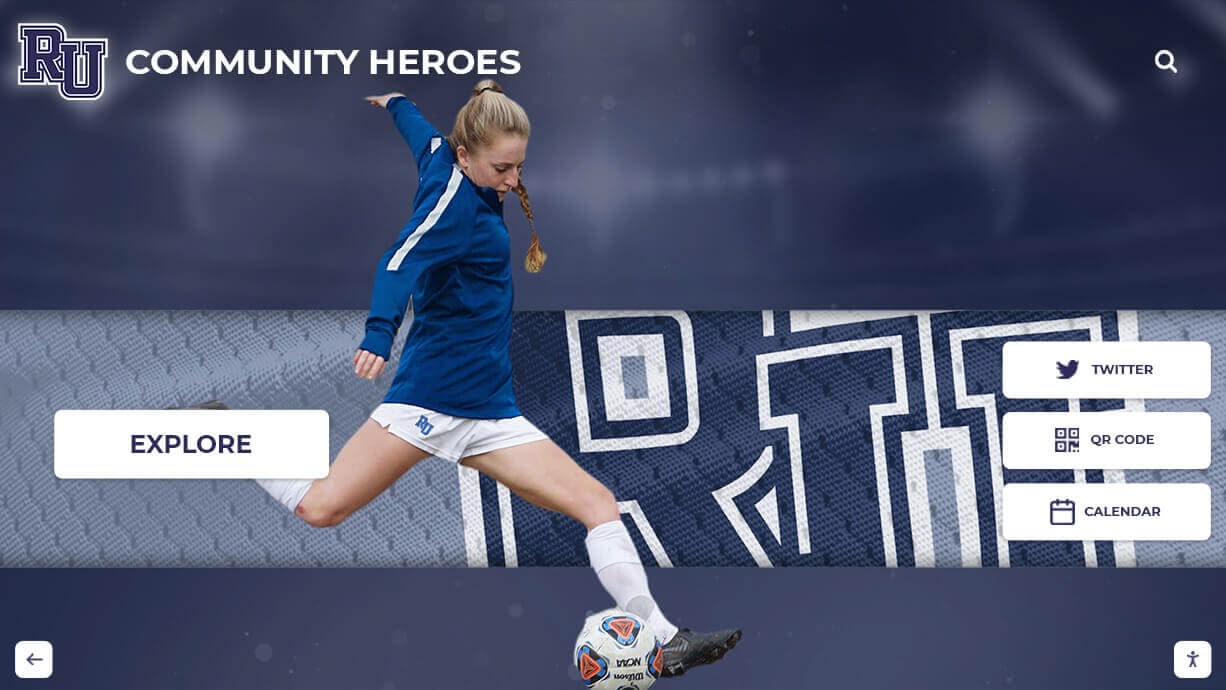
Planning Your Recognition Program
Before selecting hardware or software, institutions should define clear objectives and recognition criteria. This planning phase establishes the foundation for all subsequent decisions.
Define Recognition Categories: Determine what types of achievements warrant inclusion in your hall of fame. Categories might include athletic achievements, academic excellence, distinguished alumni, career accomplishments, community service, military service, or organizational leadership. Multiple categories create diverse entry points for visitor exploration and ensure broad representation across your community.
Establish Selection Criteria: Document clear, consistent criteria for each recognition category. Transparent criteria ensure fairness, prevent controversy, and help future selection committees make consistent decisions. Consider whether recognition is permanent or time-limited, how frequently new honorees are added, and what documentation is required to support nominations.
Assess Existing Content: Inventory what content you already have available. Many institutions discover extensive photograph collections, biographical information in various databases, and video footage from past events. Consolidating this content early streamlines the implementation process.
Identify Target Locations: Survey your facility to identify optimal display locations. High-traffic areas with natural gathering spaces work best. Consider locations such as main entrances and lobbies where visitors naturally pause, adjacent to registration or reception areas, along primary circulation corridors, near athletic facilities or gymnasiums, or in dedicated hall of fame or history galleries.
Location affects not just visibility but also technical requirements including available electrical power, network connectivity options, lighting conditions and glare, available space for viewing, and accessibility for all users.
Content Development Strategies
Content quality determines whether your interactive hall of fame becomes a valued resource or an underutilized amenity. Invest time in developing comprehensive, compelling content for each honoree.
Biographical Information: Go beyond basic facts to tell stories. Effective profiles include personal background and formative experiences, connections to your institution and how it shaped their path, major accomplishments and their significance, challenges overcome and lessons learned, current activities and ongoing contributions, and quotes or personal messages when possible.
This depth transforms simple recognition into storytelling that inspires current students, employees, or members while honoring honorees appropriately.
Visual Assets: High-quality images are essential. Gather multiple photographs for each honoree including formal portraits, action shots showing them engaged in relevant activities, historical photographs from their time at your institution, and recent images showing current activities. Photograph quality matters—grainy, low-resolution images detract from the recognition experience. When historical photographs lack sufficient resolution, consider having them professionally scanned or restored.
Video Content: Video brings recognition to life in ways text and static images cannot match. Even brief video clips create emotional connections and engagement. Consider recording honoree interviews and messages, achievement highlights and footage, testimonials from colleagues or peers, or historical footage from significant events. Creating engaging video content requires planning but delivers exceptional return on the effort through increased engagement and memorable experiences.
Organizational Structure: How you organize content significantly impacts user experience. Effective hall of fame displays support multiple navigation paths including alphabetical listings, recognition category browsing, chronological timelines, keyword search, and filtered views by graduation year, department, achievement type, or geographic location. This flexibility accommodates different visitor goals—some searching for specific individuals, others exploring broader achievement patterns.

Software Solutions for Interactive Recognition
While interactive panels provide the hardware foundation, specialized software delivers the user experience and content management capabilities that determine long-term success.
Essential Software Features
Purpose-built hall of fame software should provide specific capabilities that generic digital signage or presentation software typically lacks:
Intuitive User Interface: The public-facing interface must be immediately understandable to visitors encountering it for the first time, with no training or instructions required. Design principles include clear visual hierarchy directing attention to important elements, familiar navigation patterns using standard gestures and conventions, responsive feedback confirming user actions, and accessible design supporting users of varying abilities.
Powerful Search and Filtering: Visitors should be able to locate content through multiple methods including text search with auto-complete suggestions, category filtering for browsing specific achievement types, date range selection for exploring particular eras, and advanced filters combining multiple criteria. Search functionality transforms casual browsing into purposeful exploration, significantly increasing engagement time and content discovery.
Content Management System: Behind the public interface, administrators need tools for managing content efficiently. Essential content management features include intuitive profile creation workflows, bulk import capabilities for adding multiple honorees efficiently, media library management for organizing photographs and videos, approval workflows for reviewing content before publication, version control and revision history, and scheduled publishing for automating new honoree additions.
Solutions like Rocket Alumni Solutions provide purpose-built content management designed specifically for recognition programs, streamlining workflows and reducing administrative burden.
Analytics and Reporting: Understanding how visitors interact with your hall of fame informs content strategy and demonstrates value. Useful analytics include overall engagement metrics such as session duration and return visitors, content performance showing which honorees generate the most interest, search query analysis revealing what visitors seek, peak usage times identifying optimal display locations and timing, and demographic insights when integrated with other systems.
These metrics help justify investment, guide content development priorities, and identify opportunities for improvement.
Integration Considerations
Interactive hall of fame displays often need to connect with other institutional systems:
Alumni Databases: Many institutions maintain comprehensive alumni databases with contact information, graduation details, and giving history. Integrating your hall of fame display with these systems enables automatic updates when alumni information changes, seamless donor recognition displays showing giving levels and impact, and personalized experiences when alumni check in or identify themselves.
Digital Asset Management: Organizations with extensive photograph and video collections benefit from connecting hall of fame displays to digital asset management systems. This integration centralizes media storage, ensures content consistency across platforms, simplifies workflows for updating images, and preserves institutional memory in organized, accessible formats.
Event Management Systems: Connecting hall of fame displays to event calendars and registration systems enables dynamic content tied to specific events, such as featuring homecoming honorees during reunion weekends, highlighting scholarship recipients during fundraising galas, or showcasing speakers or performers appearing at campus events.
Social Media Platforms: Modern audiences expect to share content they find meaningful. Hall of fame displays with social sharing capabilities extend recognition beyond physical locations, increase visibility for honorees and your institution, and encourage alumni engagement through digital channels.
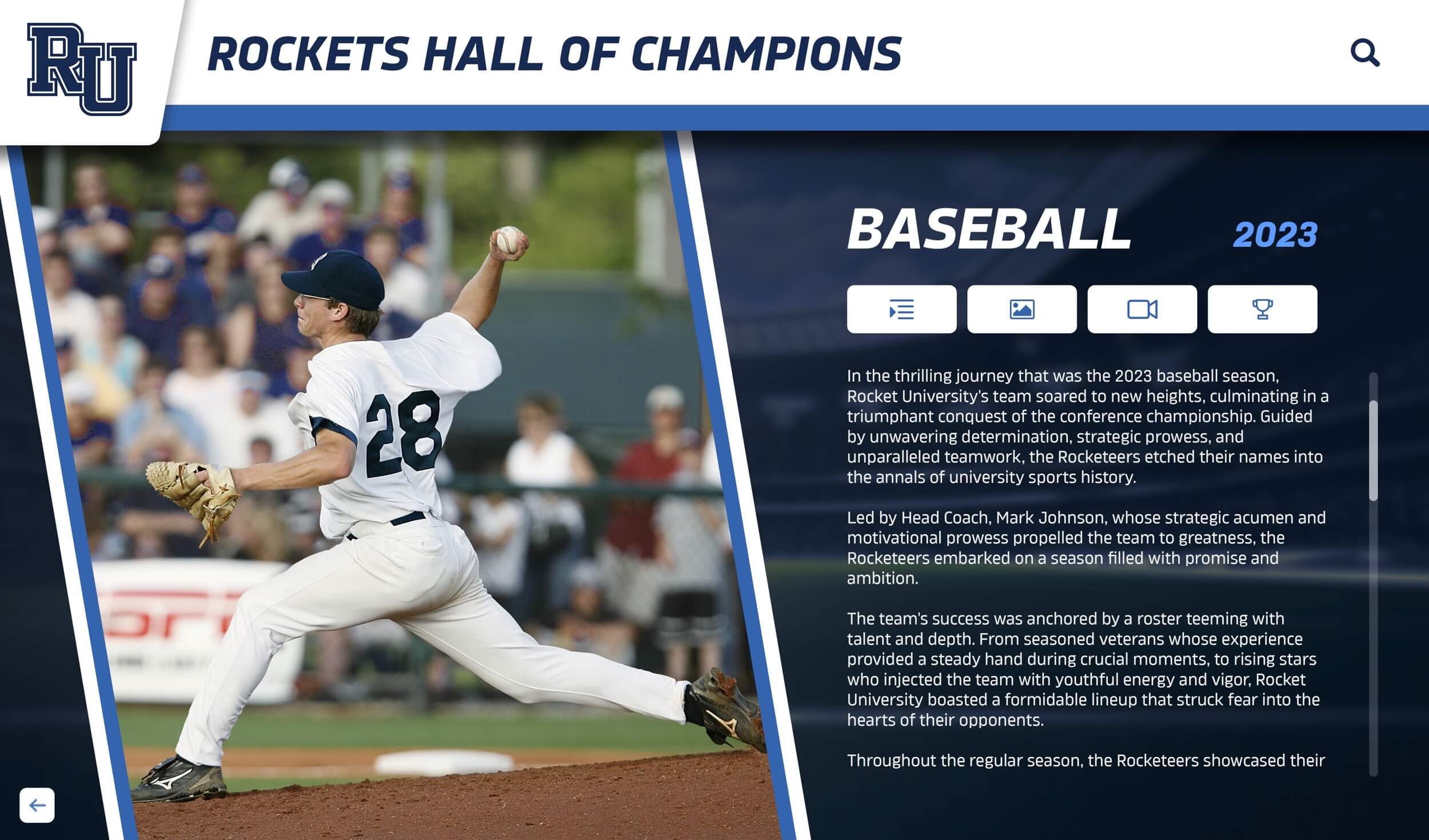
Best Practices for Engagement and Impact
The most successful interactive hall of fame implementations follow proven practices that maximize visitor engagement and institutional benefit.
Strategic Content Curation
Balance Historical and Contemporary Recognition: Effective hall of fame displays span institutional history, featuring honorees from founding years through recent graduates or members. This temporal breadth demonstrates sustained excellence while showing how your institution has evolved. Organize content to enable both chronological exploration and category-based browsing, allowing visitors to discover patterns and connections across eras.
Feature Diverse Achievements: Recognition that spans multiple dimensions of excellence resonates with broader audiences. Include not just the most prominent or traditional achievements but also community impact, creative accomplishments, entrepreneurial success, and service contributions. Diversity in recognition categories ensures that more current students, employees, or members can envision themselves as future honorees.
Refresh Featured Content Regularly: While your complete hall of fame database may remain relatively stable, featured content should rotate regularly. Monthly or quarterly featured honoree rotations give repeat visitors new content to discover, tie recognition to current events or seasons, maintain staff engagement with content management, and create ongoing social media and communications opportunities.
Content planning strategies should include editorial calendars that align with institutional rhythms such as homecoming, commencement, and major anniversaries.
Promotional Integration
Interactive hall of fame displays deliver maximum value when integrated into broader institutional communications and programs:
Campus Tours and Orientation: Train tour guides to incorporate hall of fame displays into standard routes. Position displays as storytelling opportunities that illustrate institutional values, showcase possible career paths, and demonstrate the lasting impact of the student, employee, or member experience. Prospective students, new employees, and potential members form impressions during these early interactions—compelling recognition stories strengthen recruitment and retention.
Alumni Events and Reunions: High school reunions, college homecoming weekends, and organizational anniversaries provide natural opportunities to leverage hall of fame displays. Create special featured content for reunion classes, organize reception areas near displays to encourage exploration, and include display tours in event programming.
Fundraising Initiatives: The connection between recognition and philanthropy is well-documented. Hall of fame displays support fundraising by demonstrating institutional impact through honoree stories, showcasing donor recognition for giving programs, creating emotional connections that inspire support, and providing venues for donor appreciation events.
Digital Extension and Remote Access: Physical interactive displays serve on-site visitors, but web-based extensions allow global audiences to explore recognition content. Virtual hall of fame platforms complement physical displays by enabling remote alumni to search for classmates, sharing profiles via social media and email, expanding recognition reach beyond physical visitors, and creating year-round engagement opportunities.
Accessibility and Inclusive Design
Thoughtful implementation ensures all visitors can engage with recognition content regardless of physical ability, age, or technical familiarity:
Physical Accessibility: Mount displays at heights accommodating wheelchair users, typically with screen centers 48-54 inches above the floor. Ensure adequate clear space in front of displays for wheelchair maneuverability. Avoid locations where glare or backlighting impairs visibility.
Interface Accessibility: Design user interfaces with accessibility features including adjustable text sizes, high-contrast display modes for users with visual impairments, simple navigation not requiring complex multi-touch gestures, and audio description capabilities. These features ensure inclusive experiences for all visitors.
Language Accessibility: For institutions serving diverse populations, consider providing content in multiple languages. Interface language selection and translated profile content expand access and demonstrate institutional commitment to inclusivity.
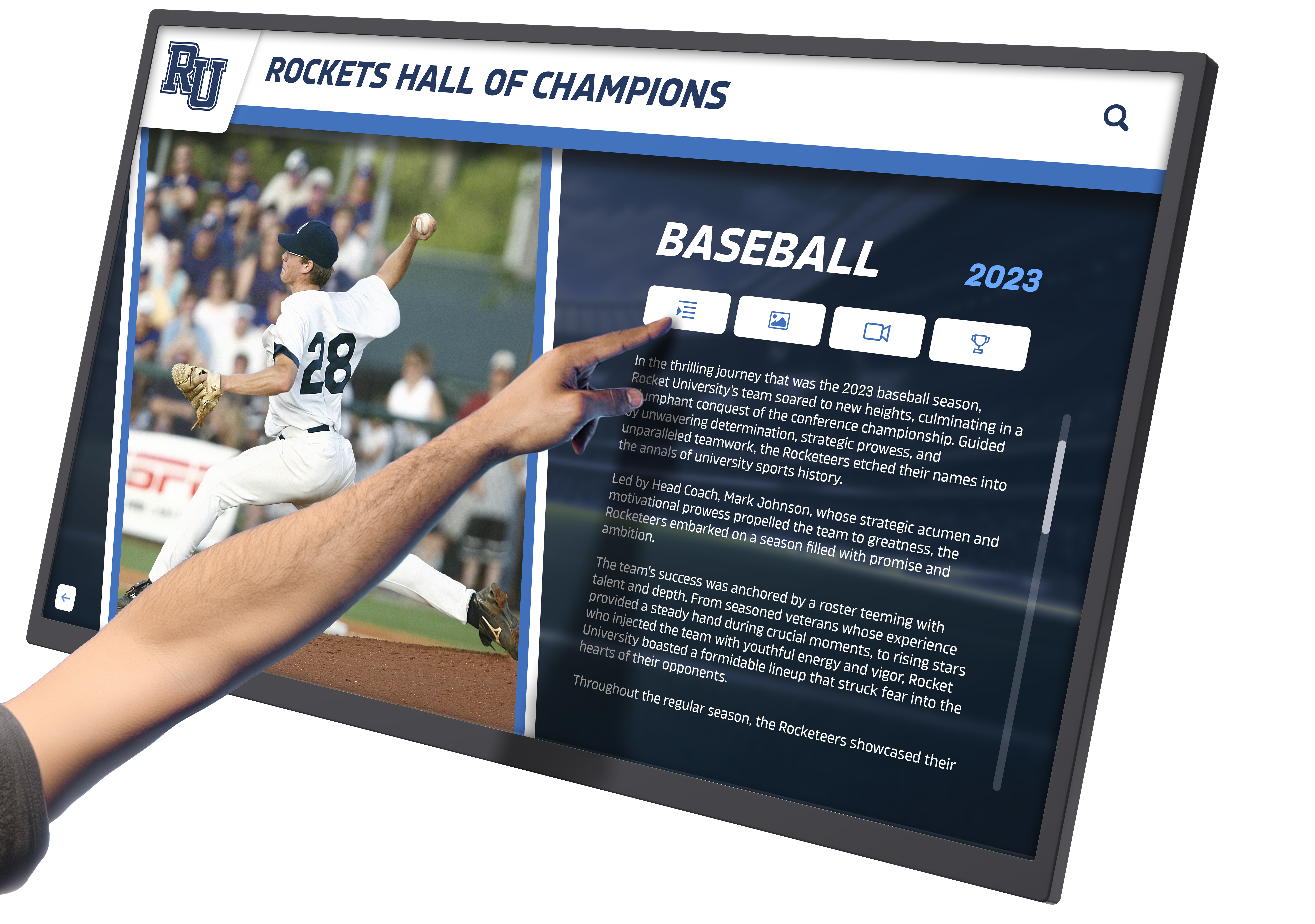
Technical Implementation Considerations
Beyond software and content, several technical factors determine successful deployment.
Hardware Selection and Specifications
When evaluating interactive panels for hall of fame applications, consider specifications beyond those emphasized for educational or presentation uses:
Continuous Operation Rating: Hall of fame displays may need to operate 12-16 hours daily, seven days weekly. Verify that panels are rated for continuous operation rather than intermittent use. Commercial-grade displays designed for digital signage applications typically provide better reliability for always-on scenarios than panels designed primarily for periodic interactive sessions.
Screen Burn-In Prevention: Static interface elements displayed for extended periods can cause image retention or burn-in on some display technologies. Look for panels with pixel-shifting features, automated screen savers, or other burn-in prevention technologies. Content design should also incorporate strategies to minimize static elements.
Heat Management: Interactive displays generate significant heat during continuous operation. Ensure adequate ventilation around the display and in the installation location. Some installations benefit from active cooling solutions or climate-controlled enclosures.
Network Connectivity: Reliable network connections enable remote content management, software updates, and analytics reporting. Hardwired Ethernet connections provide maximum reliability. If WiFi connectivity is necessary, ensure robust signal strength at the display location and implement network monitoring.
Installation and Setup
Professional installation is essential for displays weighing hundreds of pounds and costing tens of thousands of dollars:
Structural Assessment: Verify that wall structures can support display weight, especially for large-format panels. Concrete or solid masonry walls provide the strongest mounting surfaces. Drywall installations require locating studs and using appropriate reinforcement.
Electrical Requirements: Interactive displays typically require dedicated 15-20 amp circuits. Plan electrical routing to avoid exposed conduits that detract from aesthetic presentation. Consider incorporating surge protection to guard against power fluctuations.
Cable Management: Thoughtful cable management maintains clean, professional appearances. In-wall routing conceals power and network cables entirely. Surface-mounted solutions should use cable channels or conduits that complement interior design.
Environmental Considerations: Assess lighting conditions at different times of day. Displays near windows may experience glare that impairs visibility. Anti-glare screens or strategic positioning can mitigate these issues. Temperature and humidity should remain within manufacturer specifications—avoid locations near heating vents or in un-climate-controlled spaces.
Maintenance and Support
Plan for ongoing maintenance to ensure reliable operation:
Routine Cleaning: Touchscreens require regular cleaning to maintain responsive touch performance and visual clarity. Use cleaning solutions and materials recommended by the manufacturer—improper cleaning agents can damage touch sensors or display coatings. Establish cleaning schedules based on usage intensity and environmental conditions.
Software Updates: Content management platforms and display operating systems require periodic updates for security, bug fixes, and new features. Implement update procedures that minimize downtime and test updates before deployment to production displays.
Content Backup: Regularly backup hall of fame content and configuration settings. Cloud-based content management systems typically provide automatic backups, but verify that backup procedures are functioning and restoration processes are documented.
Technical Support Arrangements: Establish clear support pathways for troubleshooting issues. White-glove support programs provide dedicated assistance for complex recognition systems, minimizing downtime and ensuring prompt resolution of problems.
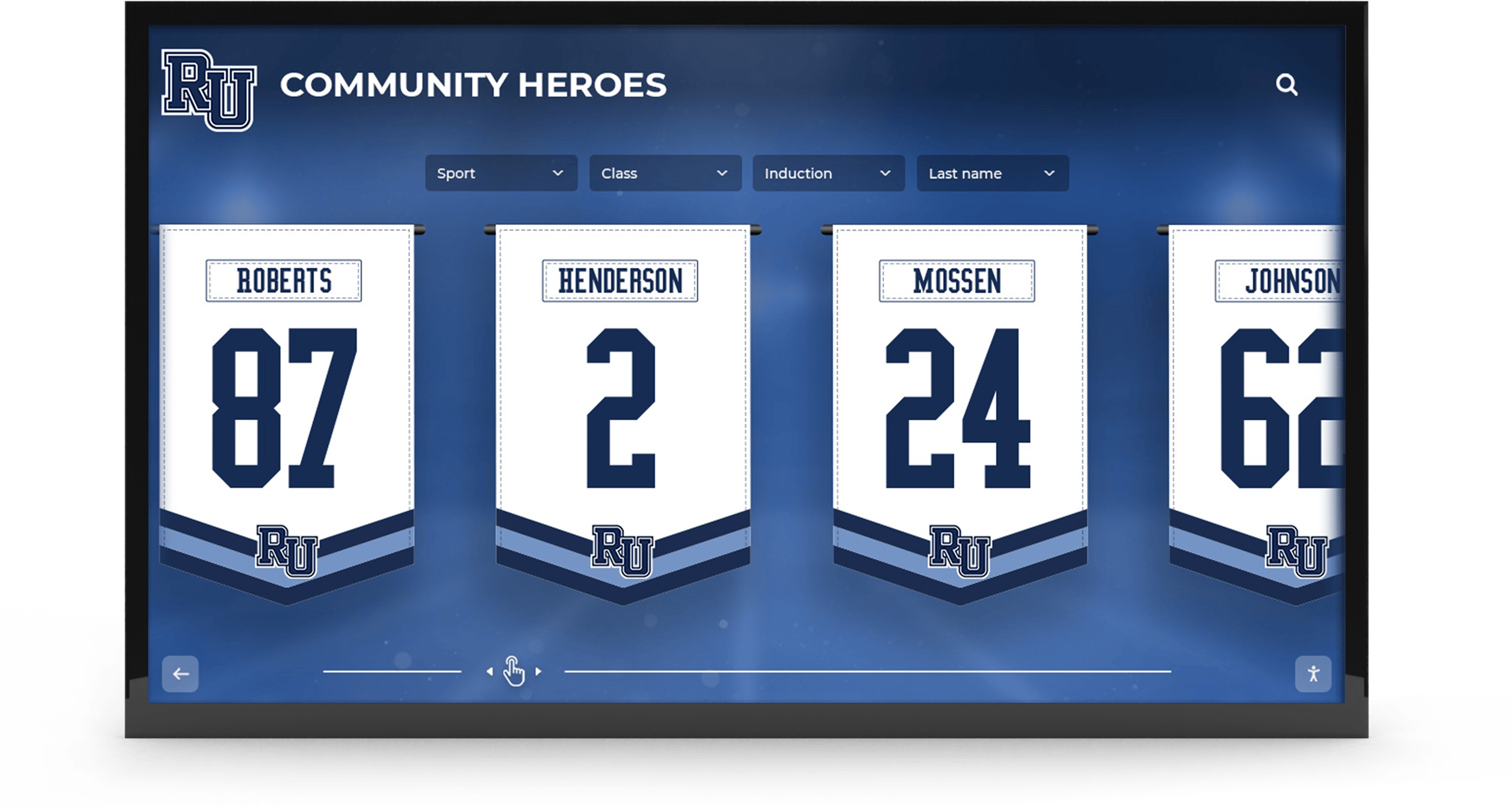
Measuring Return on Investment
Interactive hall of fame displays represent significant investments. Demonstrating return on investment helps justify expenditure and secure ongoing support.
Quantifiable Metrics
Several metrics provide objective measures of impact:
Engagement Analytics: Track average session duration, total number of sessions, repeat visitor rates, and search queries and content views. Sustained engagement indicates that content resonates with visitors and delivers value. Sessions lasting several minutes suggest meaningful exploration rather than cursory interaction.
Alumni Participation: Monitor changes in alumni engagement metrics following display implementation, including alumni association membership rates, event attendance figures, volunteer participation, and online community activity. While multiple factors influence these metrics, interactive recognition displays often contribute to improved engagement.
Fundraising Indicators: Assess philanthropic trends following implementation, including donor participation rates, average gift sizes, planned giving inquiries, and capital campaign progress. The ROI of digital alumni recognition often manifests through increased charitable support as recognition strengthens emotional connections to the institution.
Recruitment Impact: For educational institutions, evaluate whether prospective student perceptions improve following hall of fame implementation. Survey data, yield rates, and enrollment figures may show positive trends attributable in part to enhanced recognition displays featured during campus visits.
Qualitative Outcomes
Beyond quantifiable metrics, interactive hall of fame displays deliver qualitative benefits:
Enhanced Institutional Pride: Recognition displays contribute to sense of community and pride among students, employees, and members. This cultural impact, while difficult to measure precisely, manifests in improved morale, stronger identification with institutional values, and enhanced esprit de corps.
Storytelling Platform: Hall of fame displays become vehicles for institutional storytelling, preserving and sharing history in accessible formats. This archival function gains value over time as institutional memory might otherwise fade.
Recruitment and Retention Tool: Prospective members, students, or employees form impressions based on how institutions honor achievement. Compelling recognition demonstrates that contributions will be valued and remembered, supporting recruitment and retention objectives.
Donor Stewardship: For fundraising programs, recognition displays function as stewardship tools that show donors how their support creates lasting impact. This stewardship strengthens donor relationships and encourages continued support.
Alternatives and Complementary Solutions
While ClearTouch panels represent one hardware option for interactive recognition displays, institutions should consider the complete ecosystem of solutions available.
Purpose-Built Recognition Software
The software platform powering your hall of fame display matters more than the specific hardware brand. Purpose-built recognition solutions like Rocket Alumni Solutions are designed specifically for hall of fame applications, offering features including intuitive content management tailored to recognition workflows, customizable recognition categories and criteria, powerful search and discovery tools optimized for visitor exploration, robust multimedia support for photos, videos, and interactive timelines, detailed analytics showing engagement patterns, and responsive design adapting to various display sizes and orientations.
These specialized platforms integrate seamlessly with various display hardware brands, allowing institutions to select hardware based on budget, specifications, and preferences while maintaining sophisticated software capabilities.
Hybrid Physical-Digital Recognition
Some institutions implement hybrid approaches that combine digital displays with traditional physical recognition elements:
Digital Displays as Discovery Tools: Digital trophy cases and interactive displays can complement physical trophies, plaques, and memorabilia by providing searchable context, detailed stories, and multimedia content that physical displays cannot accommodate.
Wayfinding to Physical Recognition: Interactive displays can serve as indexes guiding visitors to physical recognition locations throughout facilities. This approach is particularly useful in large institutions with recognition elements distributed across multiple buildings.
Rotating Physical Displays: Digital content management can drive physical display updates. Some systems use digital screens to showcase featured honorees while maintaining permanent physical recognition for inductees. This combination provides flexibility of digital updates with tangible permanence of physical recognition.
Mobile and Web Extensions
Interactive hall of fame experiences need not be confined to single physical displays:
Mobile Applications: Mobile companion apps allow alumni, students, or members to explore hall of fame content from anywhere. Mobile platforms can include social features for connecting with fellow community members, notification systems for new inductees or upcoming events, and augmented reality experiences overlaying digital content on physical locations.
Online Hall of Fame Websites: Web-based hall of fame platforms extend recognition to global audiences who may never visit physical locations. Online versions support search engine discoverability, social media sharing, and year-round engagement.
QR Code Integration: Physical recognition elements can include QR codes that visitors scan to access extended digital content on personal devices. This bridges physical and digital recognition methods, allowing compact physical plaques to link to comprehensive digital profiles.

Future Trends in Interactive Recognition
The field of digital recognition continues evolving with new technologies creating additional possibilities for engaging, immersive experiences.
Artificial Intelligence and Personalization
Next-generation recognition systems may incorporate AI capabilities including personalized content recommendations based on viewing history, natural language search enabling conversational queries, facial recognition allowing alumni to check in and see personalized content, and automated content generation creating biographical summaries from structured data.
These AI-enhanced features promise to make recognition displays even more engaging and relevant to individual visitors.
Augmented and Virtual Reality
Emerging technologies like AR and VR create new dimensions for recognition experiences:
Augmented Reality Overlays: Visitors using smartphones or tablets might view physical spaces overlaid with digital recognition content. Pointing a device at a building could surface historical information and stories of notable alumni associated with that location.
Virtual Reality Tours: VR experiences could allow remote alumni to virtually visit campus and explore hall of fame displays as if physically present. This technology is particularly valuable for institutions with geographically dispersed alumni communities.
Mixed Reality Experiences: Combining physical and digital elements, mixed reality could enable interactive holographic displays or projection mapping that transforms entire rooms into immersive recognition environments.
Advanced Analytics and Engagement Tracking
Future recognition systems will likely provide even more sophisticated analytics including heatmapping showing exactly where visitors focus attention, predictive analytics identifying content likely to engage specific visitor segments, sentiment analysis of visitor feedback and social media mentions, and conversion tracking connecting recognition engagement to specific outcomes like giving or event attendance.
These advanced analytics will enable data-driven optimization of recognition content and strategies.
Getting Started: Implementation Roadmap
For institutions ready to implement interactive hall of fame solutions, following a structured roadmap increases likelihood of success.
Phase 1: Discovery and Planning (1-2 Months)
Begin with thorough planning that establishes clear vision and parameters:
Assemble Stakeholder Team: Include representatives from advancement or development, alumni relations, communications and marketing, IT and facilities, and academic or organizational leadership. This cross-functional team ensures all perspectives inform planning and secures necessary organizational support.
Define Objectives and Scope: Articulate specific goals your hall of fame should accomplish, such as honoring achievement, inspiring current community members, strengthening alumni engagement, or supporting fundraising initiatives. Clear objectives guide subsequent decisions about content, features, and measurement.
Assess Current State: Inventory existing recognition methods, available content and media assets, technical infrastructure and capabilities, and budget parameters and funding sources. Understanding your starting point helps identify gaps and requirements.
Research Solutions: Explore available software and hardware options, including visiting institutions with existing interactive recognition displays, requesting demonstrations from providers like Rocket Alumni Solutions, and reviewing case studies and implementation guides.
Phase 2: Content Development (2-4 Months)
Content development often represents the most time-intensive phase but determines ultimate success:
Establish Recognition Criteria: Document clear, transparent criteria for each recognition category. Involve stakeholders in developing criteria to ensure buy-in and fairness.
Identify Initial Honorees: Based on established criteria, select initial honorees to feature at launch. Many institutions start with 50-200 profiles and expand over time.
Gather Multimedia Assets: Collect photographs, biographical information, video footage, and other content for each honoree. This process often reveals gaps in institutional records, requiring research and outreach to alumni or families.
Create Profile Content: Write compelling biographical narratives, edit and optimize visual assets, and organize content according to defined categories and structures. Consider hiring professional writers or journalists to craft engaging stories that honor achievements appropriately.
Quality Assurance Review: Implement review processes ensuring accuracy of facts and dates, consistency in tone and formatting, appropriate rights and permissions for all media, and adherence to institutional standards.
Phase 3: Technical Implementation (2-3 Months)
Technical implementation can proceed in parallel with content development:
Select Hardware Platform: Based on space requirements, budget, and technical specifications, choose interactive display hardware. Consider factors including screen size and resolution, touch technology and responsiveness, mounting options and aesthetics, commercial-grade ratings for continuous operation, and warranty and support terms.
Choose Software Solution: Select the hall of fame software platform that will manage content and deliver visitor experiences. Evaluate options based on content management capabilities, user interface design and customization, search and filtering features, analytics and reporting, and integration capabilities with existing systems.
Plan Installation: Work with facilities and IT teams to finalize display location, install necessary electrical and network infrastructure, and prepare mounting surfaces and hardware. Ensure accessibility requirements are met.
Configure and Test: Import content to the software platform, customize interface design and branding, configure network and system settings, and conduct thorough testing of all features and functionality.
Phase 4: Launch and Promotion (1 Month)
Strategic launch maximizes initial impact and establishes engagement patterns:
Soft Launch and Refinement: Before formal announcement, conduct a soft launch with limited audiences to gather feedback, identify any technical issues, and refine content or interface elements.
Formal Launch Event: Consider hosting a dedication or unveiling event featuring newly inducted honorees or their representatives, institutional leadership and major donors, media coverage highlighting the innovation, and tours demonstrating display features and content.
Promotional Campaign: Deploy comprehensive communications across multiple channels, including website features and announcements, social media content and campaigns, alumni magazine or newsletter coverage, and press releases to local and industry media.
Integration with Events: Feature the display prominently during upcoming alumni events, campus tours, and institutional programs to build awareness and encourage adoption.
Phase 5: Ongoing Management (Continuous)
Long-term success requires sustained attention and continuous improvement:
Regular Content Updates: Establish schedules for adding new honorees, updating existing profiles with recent achievements, rotating featured content, and refreshing visual elements and interface designs.
Analytics Review: Monitor engagement metrics regularly, identify high-performing and underperforming content, track trends over time, and use insights to inform content strategy.
User Feedback: Solicit and review visitor feedback through surveys, comment features, informal observation, and social media monitoring. Use feedback to improve user experience and content.
Technical Maintenance: Maintain update schedule for software and systems, clean touchscreens regularly, monitor system health and performance, and address issues promptly with technical support.
Strategic Assessment: Conduct annual reviews assessing achievement of stated objectives, ROI across multiple dimensions, opportunities for enhancement or expansion, and alignment with evolving institutional priorities.

Conclusion: Transform Recognition with Interactive Technology
The evolution from traditional static recognition to interactive digital hall of fame displays represents more than a technological upgrade—it embodies a fundamental transformation in how institutions honor achievement, tell their stories, and engage their communities. Interactive touchscreen technology, whether using ClearTouch panels or other hardware platforms, creates dynamic recognition experiences that celebrate individuals while strengthening institutional bonds.
The most successful implementations view interactive displays not as isolated amenities but as integrated components of comprehensive recognition and engagement strategies. They combine thoughtful content development with sophisticated technology, user-centered design with institutional authenticity, and initial launches with sustained commitment to ongoing enhancement.
For schools, universities, and organizations ready to modernize recognition programs, interactive hall of fame displays offer proven solutions delivering measurable returns across multiple dimensions including increased alumni engagement and philanthropic support, enhanced institutional pride and community culture, improved recruitment of students, employees, and members, and preserved institutional history in accessible, engaging formats.
The key to success lies in combining the right hardware, specialized software designed for recognition applications, compelling content that tells authentic stories, and strategic integration with broader institutional programs and communications.
Whether you’re just beginning to explore interactive recognition or ready to implement a comprehensive solution, the time to transform your recognition program is now. Solutions like Rocket Alumni Solutions provide purpose-built platforms specifically designed for hall of fame applications, streamlining implementation and delivering the features institutions need to create engaging, effective recognition experiences.
Ready to honor your community’s achievements through interactive technology? Explore digital hall of fame implementation strategies or discover how interactive recognition displays can transform your institution’s recognition program today.
